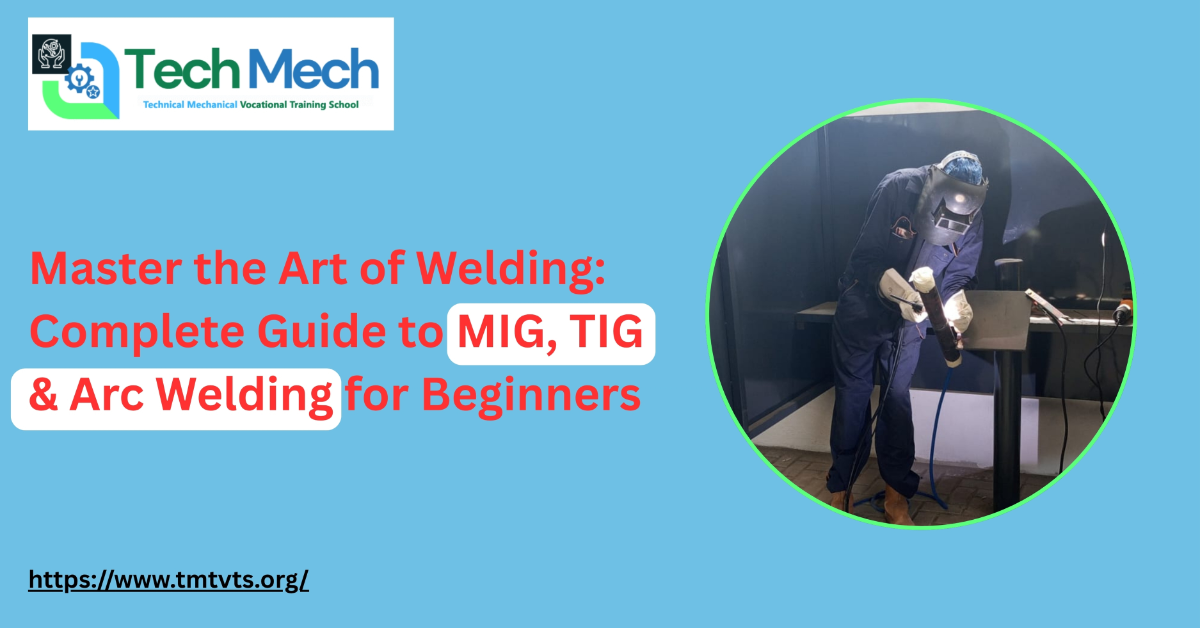Welding is one of the most in-demand technical skills in the world. From building bridges and pipelines to repairing vehicles and machinery, welders play a key role in every major industry. If you’re new to this trade and want to build a solid career, understanding the main welding processes MIG, TIG, and Arc welding is the perfect starting point. This guide explains each process in simple terms and shows how proper welding training for beginners can help you become a certified professional welder.
1. What Is Welding?
Welding is the process of joining two pieces of metal using heat and sometimes pressure. The goal is to create a strong, permanent bond between metal parts. In training, you’ll learn how to use different welding machines, control temperature, handle safety gear, and understand materials like steel, aluminum, and stainless steel.
2. The Importance of Welding Training
While some people learn by experience, proper welding training at a certified center gives you an edge. It ensures you:
- Learn correct techniques safely.
- Understand how to read welding blueprints.
- Gain hands-on experience with various machines.
- Meet international safety and quality standards.
A recognized training center also helps you prepare for industrial certifications, which can open doors to jobs in oil & gas, shipbuilding, construction, and manufacturing sectors.
3. Understanding MIG Welding (Metal Inert Gas)

MIG Welding is one of the easiest and most common welding types for beginners. It uses a wire electrode fed through a welding gun while a shielding gas protects the weld from contamination.
Why MIG is Great for Beginners:
- Simple to learn and operate.
- Works fast and clean.
- Ideal for light metal fabrication, auto repair, and home projects.
Training Focus: You’ll practice controlling wire speed, adjusting voltage, and ensuring smooth weld beads. MIG welding gives you the confidence to start working with metal almost immediately after basic training.
4. Understanding TIG Welding (Tungsten Inert Gas)

TIG Welding is more advanced and precise. It uses a tungsten electrode and requires both hands one for the torch and one for feeding filler rod. TIG welding is often used in industries where quality and appearance matter, such as aerospace and stainless-steel fabrication.
Why TIG is Important:
- Produces clean, strong, and detailed welds.
- Works perfectly on thin materials.
- Excellent for stainless steel, aluminum, and copper alloys.
Training Focus: Students learn to manage torch angle, current control, and filler rod feeding techniques. With practice, TIG welders can achieve flawless, visually appealing joints.
5. Understanding Arc Welding (Shielded Metal Arc Welding or SMAW)

Arc Welding is one of the oldest and most widely used processes. It uses a consumable electrode coated in flux to join metals. This method is popular in heavy industries like shipbuilding, construction, and pipeline work.
Why Arc Welding is Still Valuable:
- Works on thicker materials.
- Reliable in outdoor and windy conditions.
- Lower cost compared to other methods.
Training Focus: Beginners learn how to select electrodes, strike arcs correctly, and maintain proper heat control to avoid defects like porosity or cracks.
6. Essential Safety Tips for Beginners
Safety is the number one priority in any welding course. Every trainee must wear protective gear including:
- Welding helmet with auto-darkening filter.
- Flame-resistant gloves and jacket.
- Safety boots and ear protection.
Training programs teach proper ventilation, workspace organization, and first-aid basics to prevent accidents and burns.
7. Career Opportunities After Welding Training
Once you complete your welding training for beginners, many career paths open up, such as:
- Fabrication Welder
- Maintenance Welder
- Structural Welder
- Pipe Welder
- Welding Inspector or Trainer
In countries with large industrial growth like Saudi Arabia, UAE, and others skilled welders can earn competitive salaries and stable, long-term contracts.
8. Why Choose a Certified Welding Training Center
A professional training center, like TMTVTS Vocational Training Services, provides both theory and hands-on practice with modern equipment. You’ll work under certified instructors who teach you real-world techniques used in industries worldwide. By the end of your course, you’ll know how to operate multiple welding processes safely, understand drawings, and meet quality standards required by employers.
How to Apply for Welding Training at Tech Mech Vocational Training School
If you’re ready to build a rewarding career in welding, Tech Mech Technical & Mechanical Vocational Training School (TMTVTS) makes it easy to get started.
We offer beginner to advanced welding courses in MIG, TIG, and Arc welding, designed for students who want practical, hands-on experience with industry-standard equipment.
How to Apply
- Visit our training center for admission guidance and course details.
- Bring a copy of your CNIC (ID), educational documents, and two passport-size photos.
- Our admission team will help you choose the right welding program for your goals.
- Once registered, you’ll receive your training schedule and materials.
📍 Address:
Tech Mech Technical & Mechanical Vocational Training School
Building #01, Dawood Commercial Market, N-5, Near Taj Chowk, Sadiqabad
(Opposite Zaiqa Restaurant)
📞 Phone: +923032647448
✉ Email: info@tmtvts.org
🌐 Website: https://www.tmtvts.org
Why Choose Us
- Experienced certified instructors
- Practical training with real industry tools
- Internationally recognized skill development
- Affordable course fees with flexible timings
Start your welding journey today!
Visit our campus or contact us to enroll in the next batch of professional welding training courses and take the first step toward your career success.





